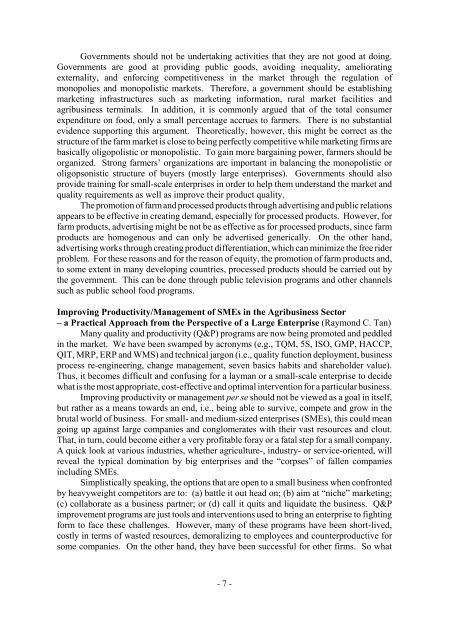Development of Agribusiness Enterprises - Asian Productivity ...
Development of Agribusiness Enterprises - Asian Productivity ...
Development of Agribusiness Enterprises - Asian Productivity ...
Create successful ePaper yourself
Turn your PDF publications into a flip-book with our unique Google optimized e-Paper software.
Governments should not be undertaking activities that they are not good at doing.<br />
Governments are good at providing public goods, avoiding inequality, ameliorating<br />
externality, and enforcing competitiveness in the market through the regulation <strong>of</strong><br />
monopolies and monopolistic markets. Therefore, a government should be establishing<br />
marketing infrastructures such as marketing information, rural market facilities and<br />
agribusiness terminals. In addition, it is commonly argued that <strong>of</strong> the total consumer<br />
expenditure on food, only a small percentage accrues to farmers. There is no substantial<br />
evidence supporting this argument. Theoretically, however, this might be correct as the<br />
structure <strong>of</strong> the farm market is close to being perfectly competitive while marketing firms are<br />
basically oligopolistic or monopolistic. To gain more bargaining power, farmers should be<br />
organized. Strong farmers’ organizations are important in balancing the monopolistic or<br />
oligopsonistic structure <strong>of</strong> buyers (mostly large enterprises). Governments should also<br />
provide training for small-scale enterprises in order to help them understand the market and<br />
quality requirements as well as improve their product quality.<br />
The promotion <strong>of</strong> farm and processed products through advertising and public relations<br />
appears to be effective in creating demand, especially for processed products. However, for<br />
farm products, advertising might be not be as effective as for processed products, since farm<br />
products are homogenous and can only be advertised generically. On the other hand,<br />
advertising works through creating product differentiation, which can minimize the free rider<br />
problem. For these reasons and for the reason <strong>of</strong> equity, the promotion <strong>of</strong> farm products and,<br />
to some extent in many developing countries, processed products should be carried out by<br />
the government. This can be done through public television programs and other channels<br />
such as public school food programs.<br />
Improving <strong>Productivity</strong>/Management <strong>of</strong> SMEs in the <strong>Agribusiness</strong> Sector<br />
– a Practical Approach from the Perspective <strong>of</strong> a Large Enterprise (Raymond C. Tan)<br />
Many quality and productivity (Q&P) programs are now being promoted and peddled<br />
in the market. We have been swamped by acronyms (e.g., TQM, 5S, ISO, GMP, HACCP,<br />
QIT, MRP, ERP and WMS) and technical jargon (i.e., quality function deployment, business<br />
process re-engineering, change management, seven basics habits and shareholder value).<br />
Thus, it becomes difficult and confusing for a layman or a small-scale enterprise to decide<br />
what is the most appropriate, cost-effective and optimal intervention for a particular business.<br />
Improving productivity or management per se should not be viewed as a goal in itself,<br />
but rather as a means towards an end, i.e., being able to survive, compete and grow in the<br />
brutal world <strong>of</strong> business. For small- and medium-sized enterprises (SMEs), this could mean<br />
going up against large companies and conglomerates with their vast resources and clout.<br />
That, in turn, could become either a very pr<strong>of</strong>itable foray or a fatal step for a small company.<br />
A quick look at various industries, whether agriculture-, industry- or service-oriented, will<br />
reveal the typical domination by big enterprises and the “corpses” <strong>of</strong> fallen companies<br />
including SMEs.<br />
Simplistically speaking, the options that are open to a small business when confronted<br />
by heavyweight competitors are to: (a) battle it out head on; (b) aim at “niche” marketing;<br />
(c) collaborate as a business partner; or (d) call it quits and liquidate the business. Q&P<br />
improvement programs are just tools and interventions used to bring an enterprise to fighting<br />
form to face these challenges. However, many <strong>of</strong> these programs have been short-lived,<br />
costly in terms <strong>of</strong> wasted resources, demoralizing to employees and counterproductive for<br />
some companies. On the other hand, they have been successful for other firms. So what<br />
- 7 -
















